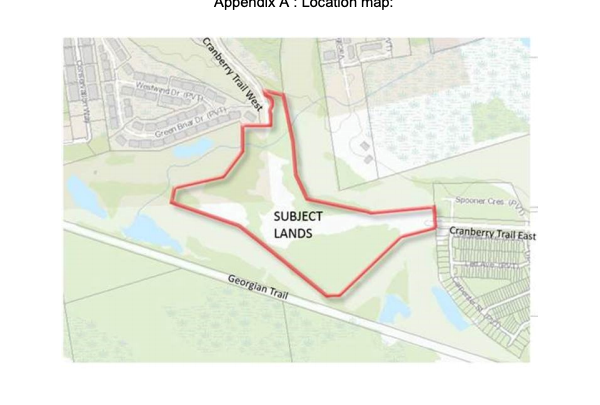The developer behind a Cranberry area subdivision will not be getting early permission to clear cut trees.
Collingwood council has been considering a request from MacPherson Builders to cut the trees down on a 7.2-hectare (17.8 acres) site between Cranberry Trail East and Cranberry Trail West. The current proposal by MacPherson is for 249 residential units (townhouses and apartments). However, the site plan hasn’t been approved by the town yet, therefore no permits have been issued to start work on the development.
The town’s bylaw states a tree cutting permit can’t be granted until the site plan is approved, but the bylaw includes an appeal process involving the developer making an application to council. This process has been followed in the past.
In this case, MacPherson’s application indicated that without the early permit, there could be a one-year delay in the construction schedule while the developer waited for bird nesting season to end. Tree cutting is prohibited (regardless of permits) between April and August for nesting reasons.
In February, staff presented a proposed agreement to council, stating MacPherson was willing to provide a financial deposit to the town as a security deposit for the trees. Should the development not proceed, the town could use the money to replant trees.
There was significant public opposition to the request for a fast-tracked tree cutting permit, including a petition and a string of emails and deputations from residents in the adjacent neighbourhoods.
Council hesitated to grant the permit, and deferred the matter during a meeting in February, asking staff to seek further legal advice regarding the town’s bylaw.
“I appreciate the deferral, it did allow a closer examination of this,” said the town’s director of planning, Adam Farr, during a council meeting on March 8.
He said the deeper review of the bylaw determined council doesn’t have “superseding authority” and would have to suspend the entire bylaw in order to allow the tree cutting to go ahead without a site plan approval. Though the town has followed this process in the past, Farr did not recommend repeating it this time.
“On the basis of that legal opinion, staff are recommending that tree removals be dealt with in the scope of the bylaw, and that this matter not be considered by council at this time,” said Farr.
Council voted unanimously to support the staff recommendation, pushing the tree removal permit back into the list of permits the developer can only obtain once the site plan is approved.
However, it prompted further discussion around the council table about bolstering communication of development proposals with residents, even beyond what is required by the planning act.
“I feel that as a council, we need to give some thought to ensuring there is notice given to communities where there are infill sites, so there aren’t surprises,” said Councillor Yvonne Hamlin.
The term “infill site” refers to a development proposed on lands that are surrounded by existing homes, in some cases the homes were built decades prior to the new development proposal.
In the case of the MacPherson proposal, the land in question is due to become phase five and six of the Blue Fairway subdivision.
While there is a mandated public notice and input requirement for any development requesting an amendment to the town’s official plan or zoning bylaw, development proposals that conform to the existing town plans don’t have to include a public notice or input process.
“I know [residents] don’t have any rights to appeal a site plan agreement,” said Hamlin. “I know there is no legal authority requiring the town to give notice, but I do think it’s the right thing to do.”
Deputy Mayor Keith Hull said the matters raised by residents neighbouring the Blue Fairway lands are concerns that have been brought forward during past development approval processes.
“As a result of what has happened in the last couple of weeks, we’ve received an abundance of correspondence outlining various concerns,” said Hull.
He said the takeaway for staff and council is to work toward enhancing communication to neighbouring constituents.
Councillor Mariane McLeod asked what powers council has to influence a development that already conforms to the town’s planning bylaws.
“There is a balance council needs to be mindful of,” responded Farr. “There are development rights and previous decisions and factors to consider that limit the municipality’s ability to act and those need to be thought through.”
In a case where a town is seen to have fallen short of its duties under the planning act or has appeared not to have allowed a development that is reasonable based on town planning bylaws, a developer can file a judicial appeal under the Local Planning Appeal Tribunal. Decisions of the tribunal will supersede or uphold decisions made by municipalities, and carry similar costs to court proceedings.
However, Farr said he and town staff are working on more detailed presentations for public meetings about zoning bylaw or official plan amendments, and he has been listening to comments from the public.
“Because of public feedback, it does raise questions for further discussion,” said Farr. “The file is still open … I do want to keep an open mind on this.”
The town’s website includes more information on the development application process, and a list of proposed developments.

